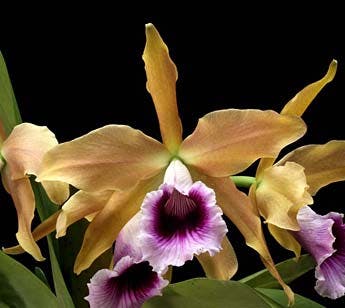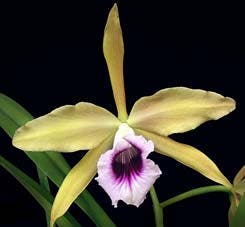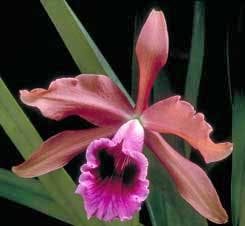
The color range of Cattleya tenebrosa can vary from copper to yellow or anywhere in beteeen such as this beautiful honey gold example.
Cattleya tenebrosa, one of the most spectacular of the former Brazilian laelias, was first described by Rolfe in 1891 as Laelia grandis var. tenebrosa in reference to its dark color compared to the yellow of L. grandis. The name tenebrosa doesn't just mean dark but rather implies a mysterious or supernatural quality. Two years later Rolfe, realizing this was a completely different species, described it as Laelia tenebrosa, a name that has effective "stuck" for nearly a hundred years. This species is closely related to L. grandis and L. purpurata and they share many characteristics. The plants and flowers tend to be larger in all respects than those of C. (L.) grandis and even many clones of C. (L.) purpurata. The Brazilian laelias differ from cattleyas in that they typically have 8 pollinia rather than the 4 typical of cattleyas and in recent years there have been several proposed transfers to Sophronitis, Hadrolaelia, Brasilaelia, and Chironiella, although molecular analysis suggests that the entire group of Brazilian laelias is best treated by including them in the genus Cattleya.

Cattleya tenebrosa '#1' x 'Walton Grange'
The species typically produces two or three, very large (over 20cm - 8") flowers per growth. The sepals and petals of most clones is an unusual bronze or copper-brown and some clones can be exceptionally dark. Like C. (L.) purpurata, the petals tend to reflex along the midrib giving many clones a rather open appearance to the flower although line-breeding is beginning to flatten many newer clones. In addition to the typical dark clones a couple of rare yellow cultivars exist. One of these yellow cultivars, C. (L.). tenebrosa 'Walton's Grange', FCC/AOS has figured prominently in the background of many exceptionally dark magenta and purple-red hybrids bred from C. dowiana and C. dowiana var. aurea.

The plants come from the southern parts of Bahia and Espirito Santo states of Brazil and flower in the early summer months. Plants can be quite tall with pseudobulbs up to 30cm (12 inches) and a rigid leaf reaching another 30cm long. The two to four, very large flowers, are borne on a strong inflorescence that can also reach another 30cm. Plants are easily cultivated under typical intermediate, Cattleya, conditions although they can be flowered with less light than C. (L.) purpurata. The plants are not nearly as tolerant of cold as C. (L.) purpurata which can be exposed to brief periods near or even below freezing. When exposed to temperatures below their liking, the plants will develop lesions on the leaves and pseudobulbs that look much like spotty sunburn but often on only surface of the leaf and not completely through the leaf. When this happens, care should be taken to prevent secondary bacterial or fungal infections until the lesions dry and stabilize.
Ron McHatton, June 2009








